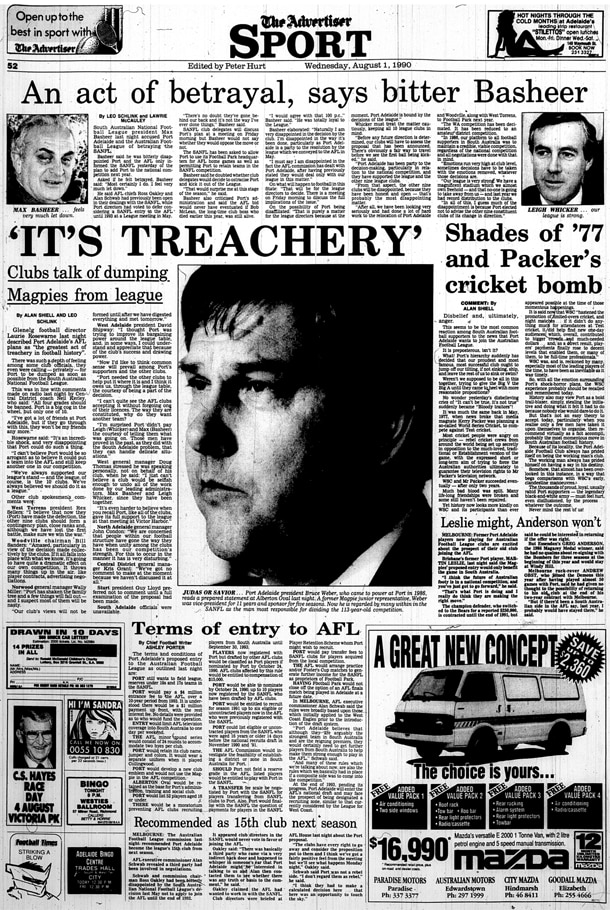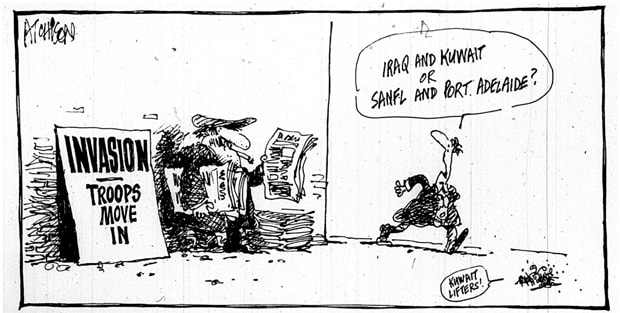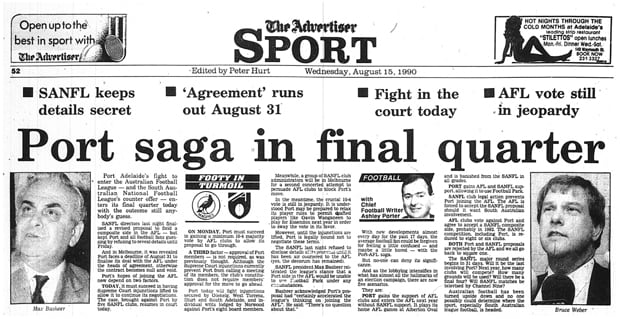As war began in the Middle East, war was unfolding on the home front for South Australians…
WINTER was like any other in Adelaide during August 1990.
And relations between Port Adelaide and the other nine SANFL league clubs, and the league itself, were undeniably frosty.
On July 30, the news many dreaded or hoped for – depending on which side of the football divide you stood – was confirmed.
Port Adelaide was the ‘interstate’ club seeking to jump the chasm from state competition to the Australian Football League.
Everyone knew the club could do it; the Magpies were preparing to leave the nest of the SANFL, which had resisted the overtures of bigger birds further along the football tree, and go it alone.
But for all the financial and identity hurdles it faced, there were some for which Port Adelaide could not have prepared.
Ultimately, its actions would result in a new bird coming to town, one with which it its supporters would forge animosity almost immediately…
WAR
In Victoria, it seemed certain. Port Adelaide was going to be the AFL’s 15th club and its move had the full backing of league chief Ross Oakley, the AFL Commission and only had to convince a majority of the league’s clubs.
A simple matter of getting down to business, dotting the I’s and crossing the T’s.
In South Australia, sensibility was abandoned and replaced with raw emotion:

The Advertiser's Sport page on August 1st, 1990 said it all. Port had ruffled feathers
Port Adelaide’s president Bruce Weber [pictured above] was the figurehead who would bear all of the back-slapping of supporters keen to join the big league, but also the barrage of animosity and aggression from those outside the club.
South Australia was fiercely parochial back then - Victoria the Antichrist – and few children back then could relate to the rivalry that has been diluted by the modern AFL.
WHO WILL BRAD SUPPORT? We visit one family from 1990, 25 years on...
The move had driven wedges through friendships, through families, through footy itself.
Forget the Kuwait invasion, the AFL invasion was here, now, and Port Adelaide was making it happen!

Local commentators labelled Port “Tough, arrogant, callous, selfish,” football figureheads said Port were “traitors” and had “ratted out” South Australian football.
Inside Alberton, Weber and his board had presented their plan to members at a special general meeting and received favourable support when the cards were laid on the table.
The battle lines were drawn, the strategies to stop Port were formulated.
Straight away, Port Adelaide’s grand plan would be threatened, and defeated.
Killed in the courts
While Port Adelaide was spruiking the huge opportunity AFL football would bring to South Australia, the responsive salvos had been fired from West Lakes:
Some were direct: Abandon the bid, or be kicked out of the SANFL.
Behind the scenes, other club directors travelled to Victoria to urge the Port bid be rejected.
The talks were given a "sympathetic" audience, but the AFL was still firm in wanting the South Australian Magpies to cross the divide.
Victorian clubs had their doubts, though.
Collingwood didn’t like it, Melbourne, Richmond and Footscray didn’t either.
Sydney, Carlton, West Coast and Geelong, it seemed, were in favour of the move early on.
Closer to the end, the AFL-Port campaign would firm the 10-4 majority required to approve the vote in Victoria.
But within days, it was clear Port Adelaide’s bid was in jeopardy at home.

Leaders of the two warring factions Max Basheer and Bruce Weber pushed their respective cases in the media, and their organisation's back rooms with the AFL.
On Thursday August 9, barely a week after the bid was revealed, Glenelg had won a temporary injunction in the courts and stopped Alberton dealing with AFL House to enter into a licence contract with the AFL.
West Torrens, South Adelaide and Sturt soon jumped on board, Norwood decided to act separately, but still against the Magpies.
That injunction was extended by the courts and completely prevented Port from dealing with the AFL, such that it would be impossible to be granted a licence by the deadline set by the Victorians.
Instead, the SANFL and other clubs rallied to provide the AFL an alternative, a composite state team that would take the place left vacant for Port.
Game over.
While the AFL stuck with Port in the short term, it eventually entered into negotiations with the SANFL to offer similar arrangements for a state team.
Through its actions, Port Adelaide had brought about the advance of the AFL into South Australia.
But it wasn’t going to be the team.
Instead, it had started the events that birthed, some might say fathered, the Adelaide Crows.
The hard work - and success - begins again
Port Adelaide had lost the battle, instead it would be the Crows that played Hawthorn in the first official AFL game at Football Park in 1991.
But the war would rage in silent for the next four years.
Silent, because Port Adelaide’s leadership resolved to work to formulate the pitch for a second club.
Premierships - eventually won in 1990, then 1992 and 1994 - were crucial.
Its supporters too formed a significant part of its pitch for only a tiny minority at most would support the Adelaide Crows with no Port officials appointed to lead the new composite team.
There would be four years to redevelop the foundations to launch the team.
After all, a latent Power in South Australian football was worth playing on the nation’s greatest stage…
THE BID PART ONE: 25 years since Port Adelaide's first attempt


